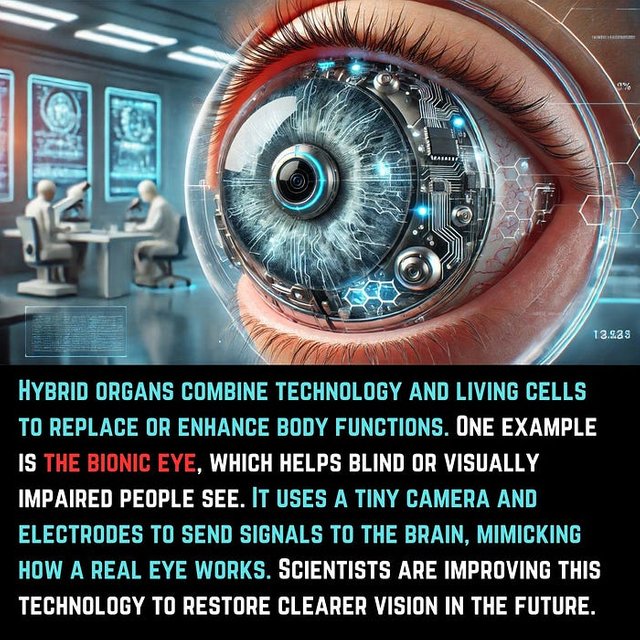Hybrid Organs: The Fusion of Machines and Human Cells
Introduction
Hybrid organs are a revolutionary innovation in medical research that combine human biological tissue with artificial components to restore or improve basic functioning. This breakthrough technique combines the best of both worlds — natural biological architecture and cutting-edge technology — to provide effective, life-enhancing solutions. One of the best-known examples is the bionic eye, which uses electronics to restore vision. However, hybrid organ technology has applications far beyond eyesight augmentation, with possible advances in the treatment of organ failure, impairments, and chronic diseases.
Understanding Hybrid Organs
Hybrid organs are artificial organs that combine biological cells and synthetic materials to mimic the functions of damaged or failing organs. Unlike typical artificial implants or prosthetics, which are solely mechanical, hybrid organs interact with the body at the cellular level, resulting in greater compatibility, functionality, and longevity. Scientists are looking at using biocompatible materials, stem cells, and bioelectronics to develop more efficient and long-lasting organ replacement solutions for patients.
The Science Behind Hybrid Organs
Hybrid organs work by combining biological tissue with advanced technology, such as sensors, microchips, and electronic interfaces. Some key components include:
- Biological Cells: Living cells (such as stem cells) are integrated into the organ to promote natural functionality and tissue regeneration.
- Biocompatible Materials: Specially designed synthetic or natural materials that can integrate seamlessly with human tissue without causing immune rejection.
- Electronic Interfaces: Sensors and microprocessors that allow the hybrid organ to communicate with the nervous system, ensuring proper function and adaptability.
- Neural Integration: Advanced neural technology enables hybrid organs to connect with the brain, allowing real-time control and feedback
Bionic Eye: A Hybrid Organ Restoring Vision
One of the most promising applications of hybrid organ technology is the bionic eye. This artificial vision device comprises of a small camera and a microelectronic chip implanted in the eye or brain to assist visually challenged people in regaining sight. The main components of a bionic eye are:
- External Camera: Captures images and transmits visual data to an internal chip.
- Microelectrode Array: Stimulates the retina or visual cortex, allowing the brain to interpret images.
- Wireless Communication System: Sends data between the external camera and internal implant.
 Bionic Eye: A Hybrid Organ Restoring Vision
Bionic Eye: A Hybrid Organ Restoring Vision
Bionic eye research is now growing rapidly, with scientists working to improve picture quality, color recognition, and real-time adaptation. Future advancements seek to totally restore sight to persons who are blind owing to disorders such as retinitis pigmentosa or macular degeneration.
Biotechnology Entrepreneurship
Other Examples of Hybrid Organs
Beyond the bionic eye, scientists are developing various hybrid organs to address different medical challenges:
- Hybrid Artificial Hearts: Combining synthetic valves with living cardiac cells to create long-lasting heart implants.
- Bionic Limbs: Prosthetic arms and legs that integrate with the nervous system, allowing natural movement and sensation.
- Artificial Pancreas: A bioengineered organ that regulates insulin levels in diabetic patients by combining live pancreatic cells with a microchip.
- Hybrid Kidneys: Artificial kidneys infused with biological filters to better mimic natural kidney function, reducing the need for dialysis.
Challenges and Future of Hybrid Organs
Despite the immense potential of hybrid organ technology, several challenges remain:
- Immune Response & Rejection: Ensuring that the body accepts hybrid organs without adverse reactions.
- Biocompatibility Issues: Developing materials that can integrate seamlessly with human tissue.
- Longevity & Durability: Enhancing the lifespan of hybrid organs through improved materials and maintenance.
- Ethical & Regulatory Concerns: Addressing the ethical implications of merging human and machine components.
As bioengineering advances, hybrid organs may one day become routine medical solutions, extending human lifespans and increasing the quality of life for millions. Future breakthroughs may potentially result in fully functional bioengineered organs, removing the need for organ donors entirely.
Biotechnology Entrepreneurship
Conclusion
Hybrid organs are ushering in a new era of medical innovation in which the combination of biology and technology can help people overcome organ failure, impairments, and chronic illnesses. With developments in biotechnology, artificial intelligence, and regenerative medicine, hybrid organs will continue to evolve, providing new hope to patients all around the world. As technology advances, these bioengineered marvels may eventually become as prevalent as standard medical implants, altering the future of healthcare.